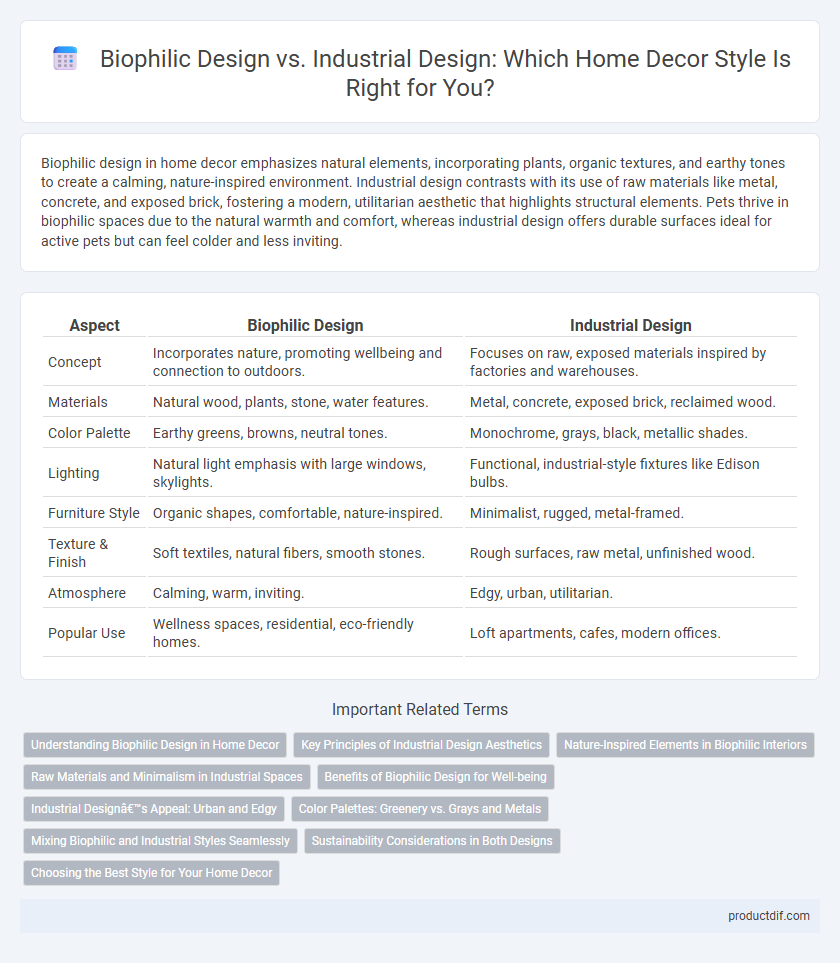Biophilic design in home decor emphasizes natural elements, incorporating plants, organic textures, and earthy tones to create a calming, nature-inspired environment. Industrial design contrasts with its use of raw materials like metal, concrete, and exposed brick, fostering a modern, utilitarian aesthetic that highlights structural elements. Pets thrive in biophilic spaces due to the natural warmth and comfort, whereas industrial design offers durable surfaces ideal for active pets but can feel colder and less inviting.
Table of Comparison
| Aspect | Biophilic Design | Industrial Design |
|---|---|---|
| Concept | Incorporates nature, promoting wellbeing and connection to outdoors. | Focuses on raw, exposed materials inspired by factories and warehouses. |
| Materials | Natural wood, plants, stone, water features. | Metal, concrete, exposed brick, reclaimed wood. |
| Color Palette | Earthy greens, browns, neutral tones. | Monochrome, grays, black, metallic shades. |
| Lighting | Natural light emphasis with large windows, skylights. | Functional, industrial-style fixtures like Edison bulbs. |
| Furniture Style | Organic shapes, comfortable, nature-inspired. | Minimalist, rugged, metal-framed. |
| Texture & Finish | Soft textiles, natural fibers, smooth stones. | Rough surfaces, raw metal, unfinished wood. |
| Atmosphere | Calming, warm, inviting. | Edgy, urban, utilitarian. |
| Popular Use | Wellness spaces, residential, eco-friendly homes. | Loft apartments, cafes, modern offices. |
Understanding Biophilic Design in Home Decor
Biophilic design in home decor emphasizes the integration of natural elements such as plants, natural light, and organic materials to create a harmonious living environment that promotes well-being and reduces stress. This approach contrasts with industrial design, which features raw materials like metal, exposed brick, and concrete, often with a more utilitarian and minimalist aesthetic. Incorporating biophilic design elements enhances air quality, boosts mood, and fosters a deeper connection to nature within urban and indoor settings.
Key Principles of Industrial Design Aesthetics
Industrial design aesthetics emphasize raw materials such as exposed brick, metal, and wood, highlighting utilitarian and functional elements. Clean lines, neutral color palettes, and minimalist forms create a rugged yet modern appeal in interior spaces. The contrast between natural textures and manufactured components defines the core visual identity of industrial design in home decor.
Nature-Inspired Elements in Biophilic Interiors
Biophilic design integrates natural elements such as plants, natural light, and organic materials to create calming, nature-inspired interiors that promote well-being. In contrast, industrial design emphasizes raw materials like exposed brick, metal, and concrete, prioritizing a rugged, urban aesthetic over natural textures. Incorporating greenery and natural patterns in biophilic interiors enhances air quality and connects occupants to the outdoors, fostering a healthier living environment.
Raw Materials and Minimalism in Industrial Spaces
Biophilic design emphasizes natural elements like wood, stone, and plants to create a connection with nature, promoting well-being through organic textures and light. Industrial design features raw materials such as exposed brick, metal, and concrete, showcasing a minimalist aesthetic with an emphasis on structural authenticity and functionality. Minimalism in industrial spaces strips decor to essential elements, highlighting the rugged beauty of unfinished surfaces and utilitarian forms.
Benefits of Biophilic Design for Well-being
Biophilic design enhances well-being by incorporating natural elements such as plants, natural light, and organic materials, which reduce stress and improve air quality. This approach promotes mental clarity and emotional balance by fostering a stronger connection to nature within living spaces. Compared to industrial design's focus on raw, utilitarian aesthetics, biophilic design creates calming environments that support physical and psychological health.
Industrial Design’s Appeal: Urban and Edgy
Industrial design's appeal lies in its raw, urban aesthetic that embraces exposed brick, metal fixtures, and reclaimed wood, creating a gritty yet stylish ambiance. This design style highlights functional elements such as exposed pipes and concrete floors, promoting an edgy, minimalist atmosphere ideal for lofts and modern city apartments. The fusion of utilitarian materials and open, airy layouts attracts those seeking a bold, contemporary home decor statement with a strong, authentic character.
Color Palettes: Greenery vs. Grays and Metals
Biophilic design emphasizes lush greenery and earthy tones, integrating vibrant greens and natural hues to evoke a calming, nature-inspired atmosphere. Industrial design favors neutral grays, raw metals like steel and iron, and muted color palettes that highlight urban, utilitarian elements. The contrast between these color schemes shapes distinct ambiances: organic warmth versus sleek, minimalist coolness in contemporary home decor.
Mixing Biophilic and Industrial Styles Seamlessly
Combining biophilic design with industrial design creates a harmonious balance between natural elements and urban aesthetics, incorporating raw materials like exposed brick and steel alongside abundant greenery and natural light. Using reclaimed wood, metal fixtures, and indoor plants enhances texture and warmth while maintaining a modern, minimalist vibe. Strategic placement of organic shapes and earthy tones softens the industrial edge, resulting in a cohesive, inviting home decor style that promotes well-being and sophistication.
Sustainability Considerations in Both Designs
Biophilic design emphasizes sustainability by incorporating natural elements like plants and organic materials, promoting energy efficiency and improving indoor air quality. Industrial design often utilizes reclaimed metals, exposed bricks, and repurposed wood, supporting eco-friendly practices through material reuse and durability. Both styles prioritize sustainable choices, but biophilic design inherently fosters a stronger connection to nature, enhancing environmental benefits.
Choosing the Best Style for Your Home Decor
Biophilic design emphasizes natural elements like plants, natural light, and organic materials to create a calming and refreshing home environment. Industrial design incorporates raw materials such as exposed brick, metal, and wood, offering a modern, edgy aesthetic that highlights structural elements. Evaluating your lifestyle, space function, and preference for warmth versus urban sleekness helps determine the ideal style to enhance your home decor.
Biophilic Design vs Industrial Design Infographic

 productdif.com
productdif.com